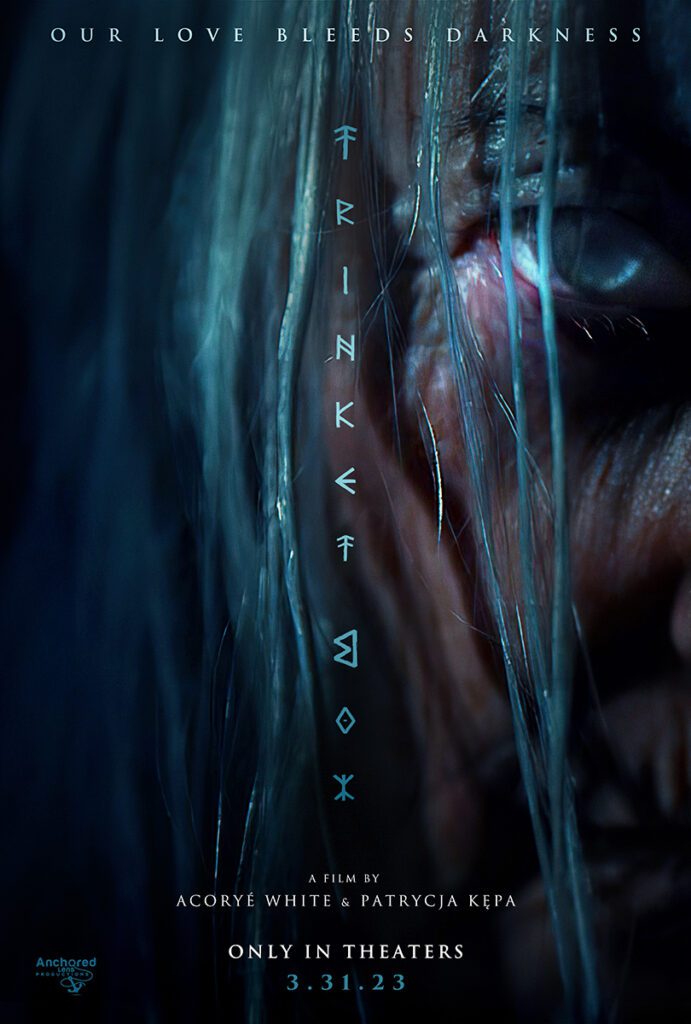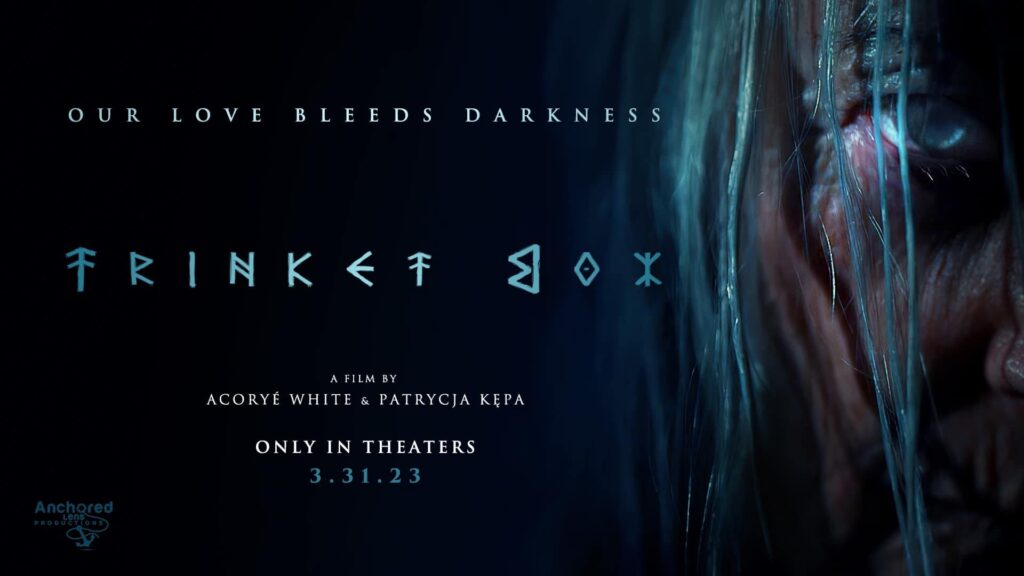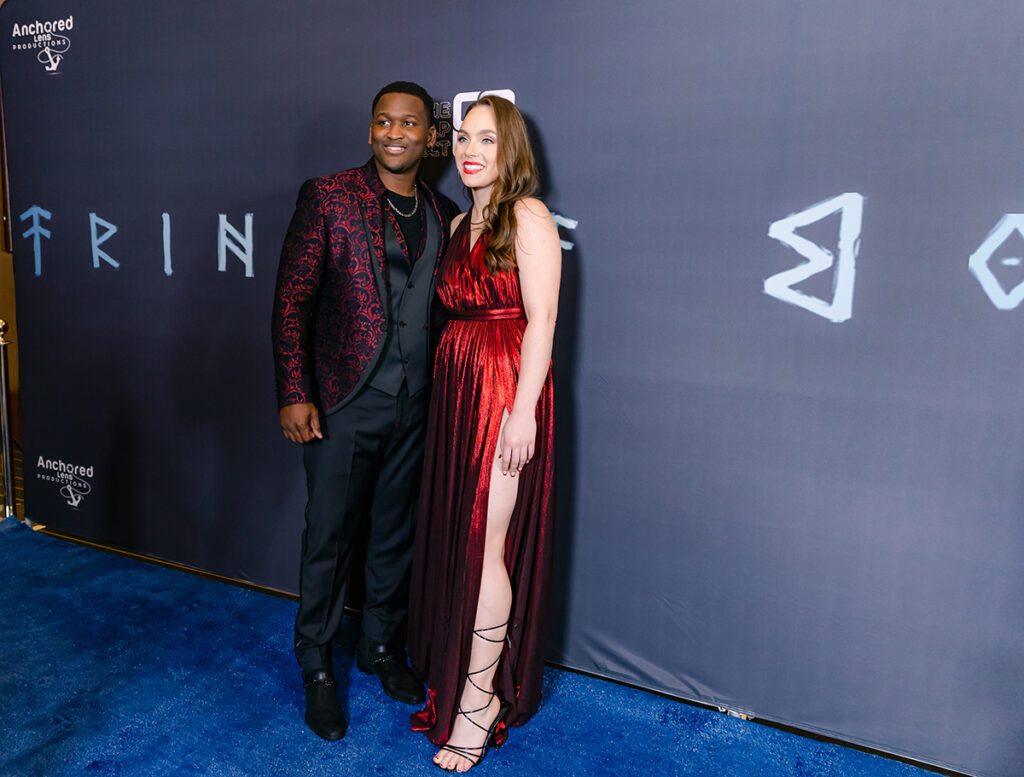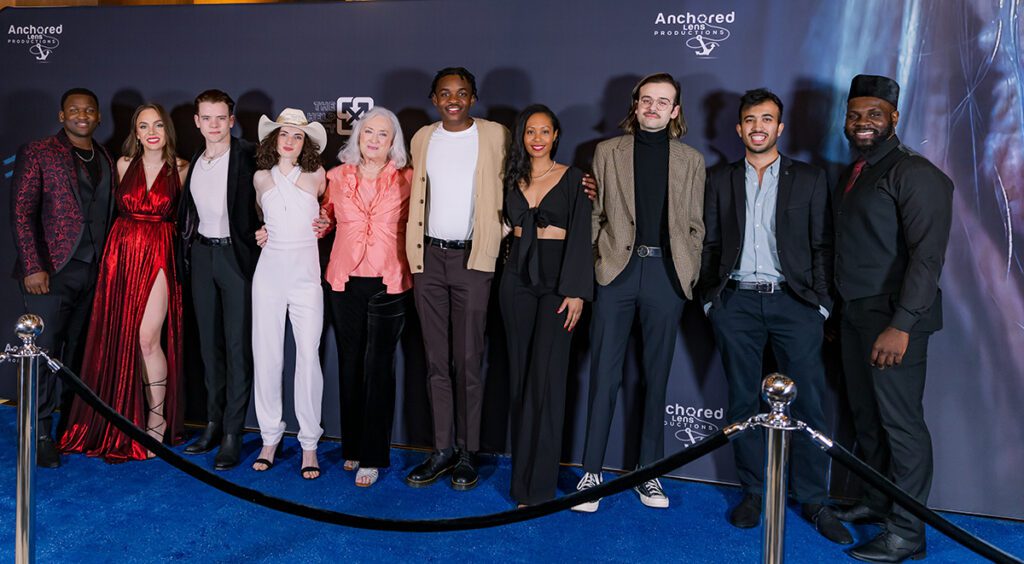
Filmmakers Acoryé White and Patrycja Kępa Take Top Spot with ‘Trinket Box’
People love a good scare and the new horror film Trinket Box, from first-time feature filmmakers Acoryé White and Patrycja Kępa, is proving that.
The independent film opened in 45 theaters in 45 different U.S. cities and earned the title as the #1 self-distributed theatrical release in 2023 and currently sits 28th in the all-time record, according to industry source The Numbers.
In recent years, White has garnered attention as an actor appearing opposite Laurence Fishburne in Under the Stadium Lights and Alfre Woodard in Juanita. Now, he can be seen starring in Trinket Box, alongside Augie Duke with Sandra Ellis Lafferty and Cindy Hogan.
The talented actor also emerges behind the scenes, co-directing, co-writing, and co-producing this terrifying tale with his partner Kepa, under their Anchored Lens Productions banner.
We caught up with Acoryé White and Patrycja Kępa to find out more about Trinket Box:

For those who haven’t seen it, can you explain the storyline of “Trinket Box”?
Acoryé White: “Trinket Box” begins with an unnerving crime scene cleanup before the story flashes back to the late 1930s, when Mary Ann, a young white girl, stumbles upon her eldest sister and black boyfriend in bed.
As the boy attempts to escape, the girls’ father discovers the indiscretion, leading to a tragic altercation. In the aftermath, Mary Ann is lured to a wicked trinket box and unknowingly unleashes a historical darkness on the family and their land.
The story returns to modern times as a young interracial couple, Mike and Ava, move into a new home filled with excitement for new beginnings. One morning, Ava is visited by Mrs. Davis, a seemingly nice elderly lady, who offers a welcome gift to the new neighbor — a trinket box.
With more frequent visits, Ava starts experiencing hallucinations, which Mike discredits, believing the old lady doesn’t approve of their relationship — until it’s too late and evil is upon them.

What compelled you to create this scary story?
Patrycja Kępa: We were actually helping two other groups of filmmakers that, unfortunately, kind of left us feeling cheated after putting so much work and time into their project.
Out of frustration, we decided that we should write our own stories and make it something relatable to us and our upbringing. We also enjoy horror, so adding that element was something we felt would be important to entice viewers and open the film to different audiences.
Additionally, creating a parallel between the past and the present within the film was an interesting way of talking about some of the underlying social themes in our story. Altogether we worked so hard to create what we felt is a good story, with an interesting plot, and heart-pounding scares.

There’s an interracial love element to the story, can you talk about the importance of that?
Kępa: We felt it was important to include interracial love in our film because it’s something very prominent in our day and age, but it’s also a very sensitive topic. Love cannot be constrained by race or color, and we wanted to show that, but also acknowledge there are obstacles that derive from entering that type of relationship.
I’m from Chicago and I only recently moved down South, so for me it was a learning experience realizing the magnitude of race is portrayed here versus where I grew up in.
Additionally, I’m a Polish immigrant. My family moved here when I was six, so for me some of the culture and mindset around race is slightly different because of my status and cultural background.
White: For me, growing up in the south I’ve seen so much good when it comes to dating interracially, but also so much bad. This time I wanted to express a little bit of both – showing that interracial love is not bad, it’s just the people who paint it out to be so. Furthermore, hate for interracial love is something that is passed down, so we just wanted to create a story that touches on a little bit of everything.

This was your debut feature film co-directing together. What was your approach as a team and did that change along the way?
White: Being an actor and having experiences on different sets where I saw people treated as less than because they weren’t the director or star actor, I wanted to do something different. Patrycja and I spoke a lot before the film planning on how we would launch who we are as directors.
We wanted to figure out if it’s really possible to make a film, be nice to our crew members and actors, and build more of a family-like dynamic rather than a hierarchy. And we achieved that!
No one had a better meal than the other person, we always gave an hour for lunch and dinner, we joined our crew members and actors during those meals and initiated conversation that built comradery and got to know each other on a much deeper level than just employer and employee.
Kępa: When it comes to how Acoryé and I worked together, we played off of each other’s strengths and weaknesses. During the entire process we both wore multiple hats and we had to make sure that roles were fulfilled. Acoryé had to act, direct, and produce, while I had to direct, producer, and be a unit production manager. However, we developed a good balance.
We both shared ideas when directing and spent hours in pre-production crafting a unified vision, angles, camera shots, specific things we wanted so if he was in front of the camera and I was directing or if I was pulled away to handle some logistics, we were in sync when it came to what we wanted for the film.

Acoryé, you star in the film but what’s your process for working with the other actors?
White: I treat every scenario according to that specific moment. For example, when I’m acting with my co-star I try to dedicate as much of myself as possible so that I’m the giving partner that she needs. I feel this is the only way to get the best performances out of each other; both of us being 100% committed to giving to the other person.
As for directing, it’s pretty easy for me because I get to relate to the actors from an understanding that most directors can’t if they haven’t acted before. This allows me to be closer to my actors, further allowing me to push and pull them in directions I need them to go. Overall, it’s a wonderful experience when you can manage both sides.
Independent films don’t always get a theatrical release in America. You managed to get it into 45 theaters in 45 cities without using a Sales Agent. How did you manage this? And what does that feel like?
White: The process for theatrical self-distribution is definitely very intense and time consuming. We spent many nights researching, writing down theaters, emailing, calling, and repeatedly following up with chains. We did this even before the movie was completed because we knew we wanted to get it out in a specific time frame before the summer Hollywood blockbusters took over.
Many theaters were hard to reach, and many didn’t get back to us at all, but we kept pushing and before we knew it we were in talks with AMC, Regal, Marcus, and Harkins, which are four of the top five theater chains in the U.S., excluding Cinemark. We landed in three of those chains, in addition to a few other recognizable chains across the U.S.
Kępa: It was difficult, especially since we are a two-person team and had to build the contacts and strategy from the ground up without any guidance. We relied on our intuition and the volume of research we conducted to help make decisions.
And although we didn’t have a sales agent or distributor specifically for U.S. theatrical, we were able to build what is now Anchored Lens’ first theatrical department which will help us maintain our relationship with theaters and continue building new ones for our future projects. Overall, we are excited about the outcome of our efforts, and we cannot wait to share the film with our theatrical audiences!

What do you hope audiences walk away from after watching “Trinket Box”?
White: When this movie is wrapped up, we simply want audiences to enjoy the film, first and foremost, but in addition, we hope people recognize the message we’re trying to relay and get one heck of a scare in the process.
Why did you want to get into movie making?
White: We wanted to tell stories that meant something to us, for one. But also, with our social impact portion of the company, media is a great way to grow rapidly and use that platform to launch our homeless awareness mission.
Kępa: For me, additionally, there aren’t a lot of Polish filmmakers in the US, let alone women, therefore, filmmaking isn’t just about storytelling but also showing little girls like me that they can do whatever they set their minds to. Acoryé feels the same way about kids that look like him and he understands that what we’re doing is important for our communities.

What types of stories are you interested most in telling in the future?
Kępa: We both really like telling true stories and incorporating real life experiences into our scripts and films. We have five true stories that our company is in development on currently, therefore the success of this project will be the catalyst for everything we’re trying to do. We also want to tell inclusive stories and really reach a wide audience with our unique approach to telling the stories.
You’ve also established a way to help others through your Anchored Lens Productions apprenticeship program. Can you tell us more about it?
White: Social impact is a big part of our company and our mission. With the apprenticeship program, we want to focus on helping homeless youth in the South by providing them with resources such as housing, transportation, support and giving them job training while they’re on set.
What’s been the biggest challenge you’ve faced so far as a filmmaker?
Kępa: Learning not to trust everything and everyone. In the beginning of this process, we trusted the wrong individuals without doing our thorough research and it cost valuable time, energy, and sleep. The good thing is that it taught us how to do almost everything on our own, but at the same time, it was a hard lesson learned.
Best piece of advice you’ve ever received?
White: For me, I heard this on one of the motivational videos I watch, but just waking up the next day is good enough to keep fighting and going for what you want. So, when we took this approach it helped us make sure we never gave up on our goal.
Kępa: Personally, the biggest advice I heard is that being so young I can try new things, make mistakes, and grow. Every experience is a good one because even if it’s not something you’re meant to do, it helps you cross it off your list.
I find that very motivational because I got stuck in a mindset that I have to have everything figured out and I’m learning that that is far from the truth. You figure a lot of things out as you go and embrace the struggle and adversity because it makes you stronger and wiser.



